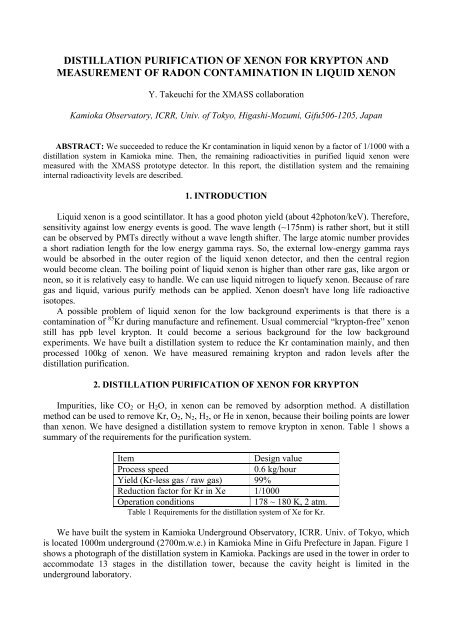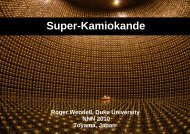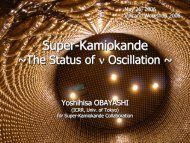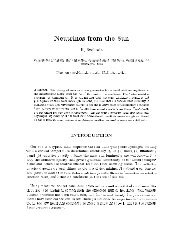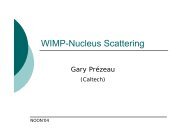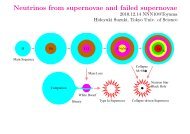distillation purification of xenon for krypton and measurement
distillation purification of xenon for krypton and measurement
distillation purification of xenon for krypton and measurement
You also want an ePaper? Increase the reach of your titles
YUMPU automatically turns print PDFs into web optimized ePapers that Google loves.
DISTILLATION PURIFICATION OF XENON FOR KRYPTON AND<br />
MEASUREMENT OF RADON CONTAMINATION IN LIQUID XENON<br />
Y. Takeuchi <strong>for</strong> the XMASS collaboration<br />
Kamioka Observatory, ICRR, Univ. <strong>of</strong> Tokyo, Higashi-Mozumi, Gifu506-1205, Japan<br />
ABSTRACT: We succeeded to reduce the Kr contamination in liquid <strong>xenon</strong> by a factor <strong>of</strong> 1/1000 with a<br />
<strong>distillation</strong> system in Kamioka mine. Then, the remaining radioactivities in purified liquid <strong>xenon</strong> were<br />
measured with the XMASS prototype detector. In this report, the <strong>distillation</strong> system <strong>and</strong> the remaining<br />
internal radioactivity levels are described.<br />
1. INTRODUCTION<br />
Liquid <strong>xenon</strong> is a good scintillator. It has a good photon yield (about 42photon/keV). There<strong>for</strong>e,<br />
sensitivity against low energy events is good. The wave length (~175nm) is rather short, but it still<br />
can be observed by PMTs directly without a wave length shifter. The large atomic number provides<br />
a short radiation length <strong>for</strong> the low energy gamma rays. So, the external low-energy gamma rays<br />
would be absorbed in the outer region <strong>of</strong> the liquid <strong>xenon</strong> detector, <strong>and</strong> then the central region<br />
would become clean. The boiling point <strong>of</strong> liquid <strong>xenon</strong> is higher than other rare gas, like argon or<br />
neon, so it is relatively easy to h<strong>and</strong>le. We can use liquid nitrogen to liquefy <strong>xenon</strong>. Because <strong>of</strong> rare<br />
gas <strong>and</strong> liquid, various purify methods can be applied. Xenon doesn't have long life radioactive<br />
isotopes.<br />
A possible problem <strong>of</strong> liquid <strong>xenon</strong> <strong>for</strong> the low background experiments is that there is a<br />
contamination <strong>of</strong> 85 Kr during manufacture <strong>and</strong> refinement. Usual commercial “<strong>krypton</strong>-free” <strong>xenon</strong><br />
still has ppb level <strong>krypton</strong>. It could become a serious background <strong>for</strong> the low background<br />
experiments. We have built a <strong>distillation</strong> system to reduce the Kr contamination mainly, <strong>and</strong> then<br />
processed 100kg <strong>of</strong> <strong>xenon</strong>. We have measured remaining <strong>krypton</strong> <strong>and</strong> radon levels after the<br />
<strong>distillation</strong> <strong>purification</strong>.<br />
2. DISTILLATION PURIFICATION OF XENON FOR KRYPTON<br />
Impurities, like CO 2 or H 2 O, in <strong>xenon</strong> can be removed by adsorption method. A <strong>distillation</strong><br />
method can be used to remove Kr, O 2 , N 2 , H 2 , or He in <strong>xenon</strong>, because their boiling points are lower<br />
than <strong>xenon</strong>. We have designed a <strong>distillation</strong> system to remove <strong>krypton</strong> in <strong>xenon</strong>. Table 1 shows a<br />
summary <strong>of</strong> the requirements <strong>for</strong> the <strong>purification</strong> system.<br />
Item<br />
Design value<br />
Process speed<br />
0.6 kg/hour<br />
Yield (Kr-less gas / raw gas) 99%<br />
Reduction factor <strong>for</strong> Kr in Xe 1/1000<br />
Operation conditions<br />
178 ~ 180 K, 2 atm.<br />
Table 1 Requirements <strong>for</strong> the <strong>distillation</strong> system <strong>of</strong> Xe <strong>for</strong> Kr.<br />
We have built the system in Kamioka Underground Observatory, ICRR. Univ. <strong>of</strong> Tokyo, which<br />
is located 1000m underground (2700m.w.e.) in Kamioka Mine in Gifu Prefecture in Japan. Figure 1<br />
shows a photograph <strong>of</strong> the <strong>distillation</strong> system in Kamioka. Packings are used in the tower in order to<br />
accommodate 13 stages in the <strong>distillation</strong> tower, because the cavity height is limited in the<br />
underground laboratory.
We have processed 100kg <strong>xenon</strong> by using<br />
the <strong>distillation</strong> <strong>purification</strong> system in March<br />
2004. It took about 1 week to process it. The<br />
raw <strong>xenon</strong> had about 3ppb <strong>krypton</strong>. We have<br />
separated about 1kg <strong>of</strong> “<strong>of</strong>f gas” <strong>xenon</strong> with 330<br />
±100 ppb <strong>krypton</strong> from the raw <strong>xenon</strong>. The<br />
amount <strong>of</strong> the purified <strong>xenon</strong> was about 99% <strong>of</strong><br />
the raw <strong>xenon</strong>. The <strong>krypton</strong> contamination in<br />
the purified <strong>xenon</strong> was assessed by a special<br />
device made with an Atmospheric Pressure<br />
Ionization Mass Spectrometer (API-MS) system<br />
<strong>and</strong> a Gas Chromatography (GC) system.<br />
Figure 1 The <strong>distillation</strong> system in Kamioka<br />
Observatory. The height <strong>of</strong> the <strong>distillation</strong> tower is<br />
about 3m.<br />
3. KRYPTON ASSAY WITH GC+API-MS SYSTEM<br />
The API-MS + GC system <strong>for</strong> <strong>krypton</strong> assay in <strong>xenon</strong> was originally developed at Taiyo Toyo<br />
Sanso Co. Ltd. (SAAN). We have measured the <strong>krypton</strong> contamination in the purified <strong>xenon</strong> by<br />
using their API-MS + GC system. In an API-MS, primary ionization is done by usual corona<br />
discharge. However, it is done in atmospheric pressure. There<strong>for</strong>e, if the carrier gas (C) has a higher<br />
ionization potential than the target molecules (X), there is the secondary ionization by ion-molecule<br />
reaction <strong>of</strong> C + + X C + X + .<br />
In this reaction, most <strong>of</strong> the target molecules are<br />
ionized by charge exchange, <strong>and</strong> then the statistical<br />
sensitivity <strong>of</strong> the Mass Spectrometer part becomes high.<br />
Table 2 shows the ionization potential <strong>of</strong> related gases.<br />
In the API-MS detector, He or Ar is used as a carrier<br />
He Ar Kr Xe<br />
eV 24.6 15.8 14.0 12.3<br />
Table 2 Ionization potential.<br />
gas. They have higher ionization potentials than Kr, so it satisfies the condition. Xenon, however,<br />
has lower ionization potentials than Kr. There<strong>for</strong>e, <strong>xenon</strong> has to be removed be<strong>for</strong>e API-MS<br />
detector so as not to ionize <strong>xenon</strong> atoms instead <strong>of</strong> <strong>krypton</strong> atoms. So, a GC system is used to<br />
separate <strong>krypton</strong> from <strong>xenon</strong>.<br />
Figure 2 shows a photograph <strong>of</strong> the CG + API-MS system at SAAN, <strong>and</strong> Figure 3 shows a<br />
schematic view <strong>of</strong> the GC + API-MS system.<br />
Figure 2 The Gas Chromatography <strong>and</strong> Atmospheric<br />
Pressure Ionization Mass Spectrometer system at<br />
SAAN.<br />
Figure 3 A schematic <strong>of</strong> the flow <strong>of</strong> the GC + API-<br />
MS system.
We have measured the <strong>krypton</strong> contamination in our purified <strong>xenon</strong> by using their API-MS +<br />
GC system in September 2004. In the first step <strong>of</strong> the <strong>measurement</strong>s, <strong>xenon</strong> gas was fed into the gas<br />
sampler, <strong>and</strong> then 5cc <strong>of</strong> the gas was sampled. Then, the sample <strong>xenon</strong> gas was fed into the GC with<br />
He carrier gas. Only at the <strong>krypton</strong> timing, the sample gas was fed into the condenser, then <strong>krypton</strong><br />
was trapped in the condenser. To increase statistical significance, we repeated these steps by 100<br />
times. Finally, the condenser was heat up, the trapped gas was fed into the API-MS system with He<br />
<strong>and</strong> Ar carrier gases through the GC system. In the final step, only <strong>krypton</strong> timing was also selected.<br />
Actually, the API-MS counts 84 Kr which is most dominant <strong>krypton</strong> isotope. The abundance <strong>of</strong> 85 Kr<br />
is small. The 85 Kr / Kr ratio is about 10 -11 . The measured 84 Kr counts are the following.<br />
Sample <strong>xenon</strong> gas<br />
Carrier He gas<br />
Krypton 50 ppt st<strong>and</strong>ard gas<br />
184.0±15.8 count<br />
(88.5±23.9) / 0.92 count<br />
(1176.9±35.7) / 0.88 count<br />
Then, the <strong>krypton</strong> concentration in the sample <strong>xenon</strong> gas was obtained as 3.3±1.1(stat.) ppt. This<br />
corresponds to about 1/1000 factor reduction <strong>of</strong> <strong>krypton</strong>, because the initial <strong>krypton</strong> contamination<br />
in the raw <strong>xenon</strong> gas was about 3ppb.<br />
4. RADON ASSAY WITH XMASS PROTOTYPE DETECTOR<br />
XMASS is an underground experiment aimed at searching <strong>for</strong> rare phenomena under an ultra<br />
low background environment by using ultra pure liquid <strong>xenon</strong> in Kamioka mine, Japan. The main<br />
physics targets <strong>of</strong> XMASS are cold dark matter, neutrinoless double beta decays, <strong>and</strong> low-energy<br />
solar neutrinos. So far, we have developed a prototype detector <strong>and</strong> done 2 series <strong>of</strong> test<br />
experiments with it. By using the prototype detector, we have assessed the remaining radon in<br />
liquid <strong>xenon</strong>.<br />
Figure 5 shows a schematic view <strong>of</strong> the<br />
prototype detector. The prototype detector<br />
consists <strong>of</strong> 100kg <strong>of</strong> liquid <strong>xenon</strong> <strong>and</strong> 54<br />
low-background Photo-Multiplier Tubes<br />
(Hamamatsu R8778) developed <strong>for</strong> this<br />
experiment. It is installed in a heavy gamma<br />
ray shield in a clean room in Kamioka<br />
Observatory. The charge in<strong>for</strong>mation from<br />
the PMTs are read by 54 channels <strong>of</strong> charge<br />
sensitive ADCs <strong>and</strong> a common Flash ADC<br />
<strong>for</strong> summed signals. The threshold <strong>of</strong> each<br />
PMT is about 0.4 photo electrons. The data<br />
acquisition trigger is applied when there are<br />
4 multiple hits within 100ns time window.<br />
The typical trigger rate <strong>for</strong> normal runs is<br />
about 1.5Hz.<br />
The radon assay was done through the<br />
following coincidence reactions.<br />
Figure 5 XMASS prototype detector. 100kg liquid<br />
<strong>xenon</strong> <strong>and</strong> 54 low-background PMTs are used. PMTs are<br />
attached to the 30L OFC chamber through 5mm<br />
thickness MgF 2 windows. They are put into a heavy<br />
shield in a clean room. The XMASS prototype detector<br />
is located in Kamioka Observatory, ICRR, Univ <strong>of</strong><br />
Tokyo, in Kamioka mine.<br />
For 222 Rn: 214 Bi (β, E max =3.3MeV) 214 Po (α, 7.7MeV, τ = 164µsec) 210 Pb<br />
For 220 Rn: 212 Bi (β, E max =2.3MeV) 212 Po (α, 8.8MeV, τ = 299nsec) 208 Pb
In the test run in August 2004, we found 67 c<strong>and</strong>idate events <strong>of</strong> the 222 Rn during 1.8 days<br />
observation. Figure 6 shows the result <strong>of</strong> the 222 Rn assay.<br />
Figure 6(a) shows the daughter energy<br />
distribution <strong>of</strong> all the time-coincidence<br />
events within 1msec. In the low-energy<br />
region, there are accidental coincidence<br />
events. There<strong>for</strong>e, we have applied a cut at<br />
3.5MeV in Fig. 6(a). Then, the remaining<br />
events became 67 events. Figure 6 (b), (c),<br />
<strong>and</strong> (d) show the distribution <strong>of</strong> these 67<br />
c<strong>and</strong>idate events. They agree with<br />
expectations.<br />
This <strong>measurement</strong> was done on 4th <strong>and</strong><br />
10th August, 2004. The live times are 0.8<br />
day <strong>and</strong> 1.0 day, respectively. If we assume<br />
radioactive equilibrium, the remaining 238 U<br />
becomes like below.<br />
4th:<br />
10th:<br />
238 U = (72±11)×10 -14 g/g<br />
238 U = (33± 7)×10 -14 g/g<br />
Figure 6 222 Rn <strong>measurement</strong>s in the test run in August<br />
2004. (a) Energy distribution <strong>of</strong> the daughter event <strong>of</strong> the<br />
coincidence events within 1msec. (b) Energy distribution<br />
<strong>of</strong> the parent events. (c) Distance between the<br />
reconstructed vertex positions <strong>of</strong> parent <strong>and</strong> daughter<br />
events. (d) Time difference between the parent <strong>and</strong><br />
daughter events. The fitted half life is 141±51µsec.<br />
The decrease <strong>of</strong> the remaining 238 U is<br />
consistent with the expected 222 Rn decay <strong>of</strong><br />
3.8 day half life. So, we think most <strong>of</strong> the<br />
remaining 222 Rn might come from outside<br />
the detector. We are planning to install a<br />
special device <strong>for</strong> radon reduction in future.<br />
We didn't find any c<strong>and</strong>idate events <strong>for</strong> 220 Rn. Then we have set a limit as 232 Th < 23 ×10 -14 g/g.<br />
5. SUMMARY<br />
We have built a <strong>distillation</strong> system <strong>of</strong> <strong>xenon</strong> <strong>for</strong> <strong>krypton</strong> removal in Kamioka Observatory. The<br />
measured reduction power was 1/1000 <strong>for</strong> <strong>krypton</strong> in <strong>xenon</strong>. The remaining <strong>krypton</strong> was measured<br />
by a GC + API-MS system. The radon contamination in liquid <strong>xenon</strong> was also assessed by the<br />
XMASS prototype detector. The current remaining impurities in purified <strong>xenon</strong> <strong>for</strong> XMASS<br />
experiment are the following.<br />
238 U = (33± 7)×10 -14 g/g<br />
232 Th < 23 ×10 -14 g/g<br />
Kr<br />
= 3.3±1.1 ppt<br />
ACKNOWLEGMENTS<br />
The author would like to thank the cooperation <strong>of</strong> the Kamioka Mining <strong>and</strong> Smelting Company.<br />
This work is partially supported by Grant-in-Aid <strong>for</strong> Scientific Research on Priority Areas (A) <strong>of</strong><br />
the Japanese Ministry <strong>of</strong> Education, Science <strong>and</strong> Culture.


